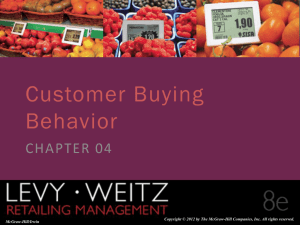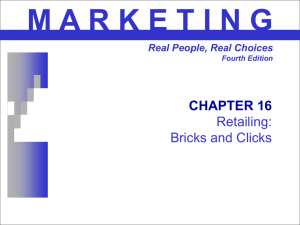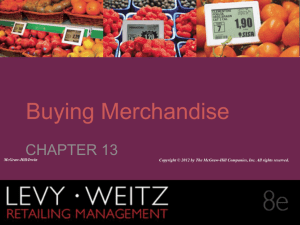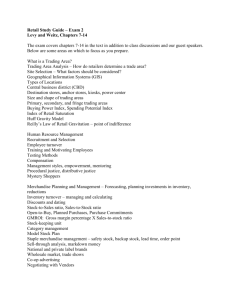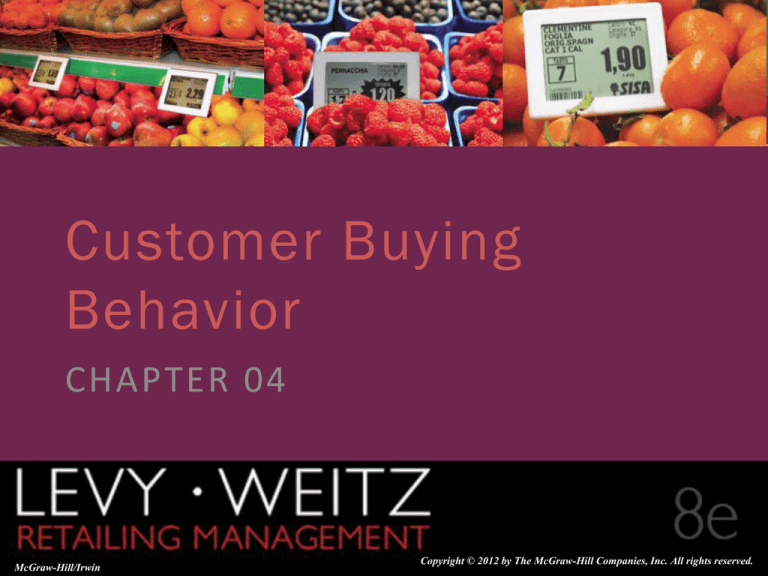
CHAPTER 4
2
1
Customer Buying
Behavior
CHAPTER 04
Retailing
Management 8e
McGraw-Hill/Irwin
4-1
Copyright
© 2012 by The McGraw-Hill Companies, Inc. All rights reserved.
© The McGraw-Hill Companies, All
rights reserved.
The World of Retailing
CHAPTER 4
2
1
Introduction to the World of Retailing
Types of Retailers
Multichannel Retailing
Customer Buying Behavior
4-2
Questions
CHAPTER 4
2
1
• How do customers decide which retailer to go to and
what merchandise to buy?
• What social and personal factors affect customer
purchase decisions?
• How can retailers get customers to visit their stores
more frequently, and buy more merchandise during
each visit?
• Why and how do retailers group customers into market
segments?
4-3
Stages in the Buying Process
CHAPTER 4
2
1
4-4
Types of Needs
CHAPTER 4
2
1
• Utilitarian Needs –satisfied
when purchases accomplish a
specific task. Shopping needs
to be easy, and effortless like
Sam’s or a grocery store.
• Hedonic needs – satisfied
when purchases accomplish a
need for entertainment,
emotional, and recreational
experience as in department
stores or specialty stores.
4-5
Hedonic Needs that Retailers can Satisfy
CHAPTER 4
2
1
• Stimulation
• Ex: Background music,
visual displays, scents
• Satisfy need for power
and status
• Ex: Canyon Ranch –
upscale health resorts
• Adventure
• Treasure hunting for
bargains
4-6
Information Search
CHAPTER 4
2
1
• Amount of Information Search Depends on the value from
searching versus the cost of searching
• Factors Affecting Amount of Information Search
• Product Characteristics
• Complexity
• Cost
• Customer Characteristics
• Past experience
• Perceived risk
• Time pressure
• Market Characteristics
• Number of alternative brands
4-7
Sources of Information
• Internal
• Past experiences
• Memory
• External
• Consumer reports
• Advertising
• Word of mouth
CHAPTER 4
2
1
Digital Vision / Getty Images
© Dynamic Graphics/Picture Quest
4-8
How Can Retailers Limit
the Information Search?
CHAPTER 4
2
1
• Information from sales associates
• Provide an assortment of services
• Provide good assortments
• Everyday low pricing
• Credit
Royalty-Free/CORBIS
4-9
Internet, Information Search,
and Price Competition
CHAPTER 4
2
1
• Profound impact on consumers’ ability to gather
external information
• Number of stores visited is no longer limited by physical
distance
• Information about the quality and performance at a low
search cost
• Retailers using an Internet channel can differentiate
their offerings by providing better services and
information
4-10
Evaluation of Alternatives
CHAPTER 4
2
1
• Multiattribute attitude model:
• Customers see a retailer, product, or service as a
collection of attributes or characteristics
• Predict a customer’s evaluation of a retailer, product,
or service based on
• Its performance on relevant attributes
• the importance of those attributes to the customer
4-11
Information Needed to
Use Multi-Attribute Model
CHAPTER 4
2
1
• Alternative Consumer Considering
• Characteristic/Benefits Sought in Making Store and
Merchandise Choices
• Ratings of Alternative Performance on Criteria
• Importance of Criteria to Consumer
4-12
Getting into the Consideration Set
CHAPTER 4
2
1
• Consideration set: the set
of alternatives the
customer evaluates when
making a selection
• Retailers develop
programs influencing topof-mind awareness
• Get exposure on search
engines like Google
• Try to be the top of the page
• More stores in the same area
(e.g., Starbucks)
4-13
Methods for increasing the chance of store visit after
getting into the consideration set
CHAPTER 4
2
1
• Increase Performance Beliefs of Your Store
• Decrease Performance Beliefs About Competitor
• Increase Importance Weight of Attributes on which You
Have an Advantage
• Add a New Benefit on which You Excel
4-14
Postpurchase Evaluation
CHAPTER 4
2
1
• Satisfaction
• A post-consumption evaluation of how well a store or
product meets or exceeds customer expectations
• Becomes part of the customer’s internal information
that affects future store and product decisions
• Builds store and brand loyalty
4-15
Types of Buying Decisions
CHAPTER 4
2
1
• Extended Problem Solving
• High financial or Social Risk
• Limited Problem Solving
• Some Prior Buying Experience
• Habitual Decision Making
• Store Brand, Loyalty
4-16
Extended Problem Solving
CHAPTER 4
2
1
Consumers devote time and effort analyzing alternatives
• Financial risks – purchasing
expensive products or
services
• Physical risks – purchases
that will affect consumer’s
health and safety
• Social risks – consumers will
believe product will affect
how others view them
4-17
What do Retailers Need to do for Customers
Engaged in Extended Problem Solving
CHAPTER 4
2
1
• Provide a Lot of
Information
• Use Salespeople rather
than advertising to
• Communicate
with customers
• Reduce the Risks
• Offer Guarantees
• Return Privileges
© Royalty-Free/CORBIS
4-18
Limited Problem Solving
CHAPTER 4
2
1
Purchase decisions process involving moderate
amount of effort and time
• Customers engage in this
when they have had prior
experience with products
or services
• Customers rely more upon
personal knowledge
• Majority of customer
decisions involve limited
problem solving
(c) Brand X Pictures/PunchStock
4-19
What do Retailers Need to do for Customers
Engaged in Limited Problem Solving?
CHAPTER 4
2
1
• It depends…
• If the Customer Is Coming to You, Provide a Positive
Experience and Create Loyalty
• Make Sure Customer is Satisfied
• Provide Good Service, Assortments, value
• Offer Rewards to Convert to Loyal Customer
• If the Customer Goes to Your Competitor’s Store, Change
Behavior
• Offer More Convenient Locations, Better Service and
Assortments
4-20
Habitual Problem Solving
CHAPTER 4
2
1
Purchase decision process involving little or no conscious effort
• For purchases that aren’t
important to the
consumer
• For merchandise
consumers have
purchased in the past
• For consumers loyal to
brands or a store
4-21
Customer Loyalty
CHAPTER 4
2
1
• Brand Loyalty
• Committed to a Specific
Brand
• Reluctant to Switch to a
Different Brand
• May Switch Retailers to Buy
Brand
• Store Loyalty
• Committed to a Specific
Retailer
• Reluctant to Switch Retailers
4-22
What do Retailers Need to do for Customers
Engage in Habitual Decision Making
CHAPTER 4
2
1
• It depends…
• If the customer habitually comes to you, reinforce
behavior
• Make sure merchandise in stock
• Provide good service
• Offer rewards to loyal customer
• If the customer goes to your competitor’s store, break
the habit
• Offer special promotions
4-23
Encouraging Impulse Buying
CHAPTER 4
2
1
• Impulse buying: one common type
of limited problem solving
• Influence by using prominent pointof- purchase (POP) or point-of-sale
(POS)
PhotoLink/Getty Images
• Have Salespeople Suggest Add-ons
• Have Complementary Merchandise
Displayed Near Product of Interest
• Use Signage in Aisle or Special Displays
• Put Merchandise Where Customers Are
Waiting
4-24
Social Factors
Influencing the Buying Decision Process
CHAPTER 4
2
1
4-25
Reference Groups
CHAPTER 4
2
1
• Reference groups affect buying
decisions by:
• Offering information
• Providing rewards for specific
purchasing behaviors
• Enhancing a consumer’s self-image
(c) image100/PunchStock
• A reference group is one or more
people whom a person uses as a basis
of comparison for beliefs, feelings and
behaviors.
4-26
Culture
CHAPTER 4
2
1
• Culture is the meaning,
beliefs, morals and
values shared by most
members of a society
• Western culture:
individualism
• Eastern culture:
collectivism
• Subcultures are distinctive
groups of people within a
culture
4-27
Criteria for Evaluating Market Segments
CHAPTER 4
2
1
Actionable
• Retailer should know what to do to
satisfy needs for the customers are
in the segment
Identifiable
• Retailer is able to determine
which customers are in the
segment
4-28
Criteria for Evaluating Market Segments
CHAPTER 4
2
1
Substantial
• Market segment must be larger
enough or its buying power
significant to generate sufficient
profits
Reachable
• Retailer can target promotions and
other elements of the retail mix to
customers in the segment
4-29
Approaches for Segmenting Markets
CHAPTER 4
2
1
4-30
Approaches for Segmenting Markets
CHAPTER 4
2
1
• Geographic segmentation groups customers according
to where they live.
• Demographic segmentation groups consumers on the
basis of easily measured, objective characteristics such
as age, gender, income, and education.
4-31
Approaches for Segmenting Markets
CHAPTER 4
2
1
• Geodemographic segmentation uses both geographic
and demographic characteristics to classify consumers.
• Lifestyle, or psychographics , refers to how people live,
how they spend their time and money, what activities
they pursue, and their attitudes and opinions about the
world in which they live.
4-32
Approaches for Segmenting Markets
CHAPTER 4
2
1
• Buying situations can influence customers with the
same demographics or lifestyle.
• Benefit segmentation groups customers seeking similar
benefits.
4-33
Keywords
CHAPTER 4
2
1
• complexity The ease with which consumers can understand and use a new fashion.
• cross-shopping A pattern of buying both premium and low-priced merchandise or patronizing expensive, statusoriented retailers and price-oriented retailers.
• everyday low pricing (EDLP) A pricing strategy that stresses continuity of retail prices at a level somewhere
between the regular nonsale price and the deep-discount sale price of the retailer’s competitors.
• impulse buying A buying decision made by customers on the spot after seeing the merchandise.
• information search The stage in the buying process in which a customer seeks additional information to satisfy a
need.
• lifestyle Refers to how people live, how they spend their time and money, what activities they pursue, and their
attitudes and opinions about the world they live in.
• multiattribute attitude model A model of customer decision making based on the notion that customers see a
retailer or a product as a collection of attributes or characteristics. The model can also be used for evaluating a
retailer, product, or vendor. The model uses a weighted average score based on the importance of various issues
and performance on those issues.
• postpurchase evaluation The evaluation of merchandise or services after the customer has purchased and
consumed them.
• satisfaction A post-consumption evaluation of the degree to which a store or product meets or exceeds
customer expectations.
• store advocates Customers who like a store so much that they actively share their positive experiences with
friends and family.
4-34


